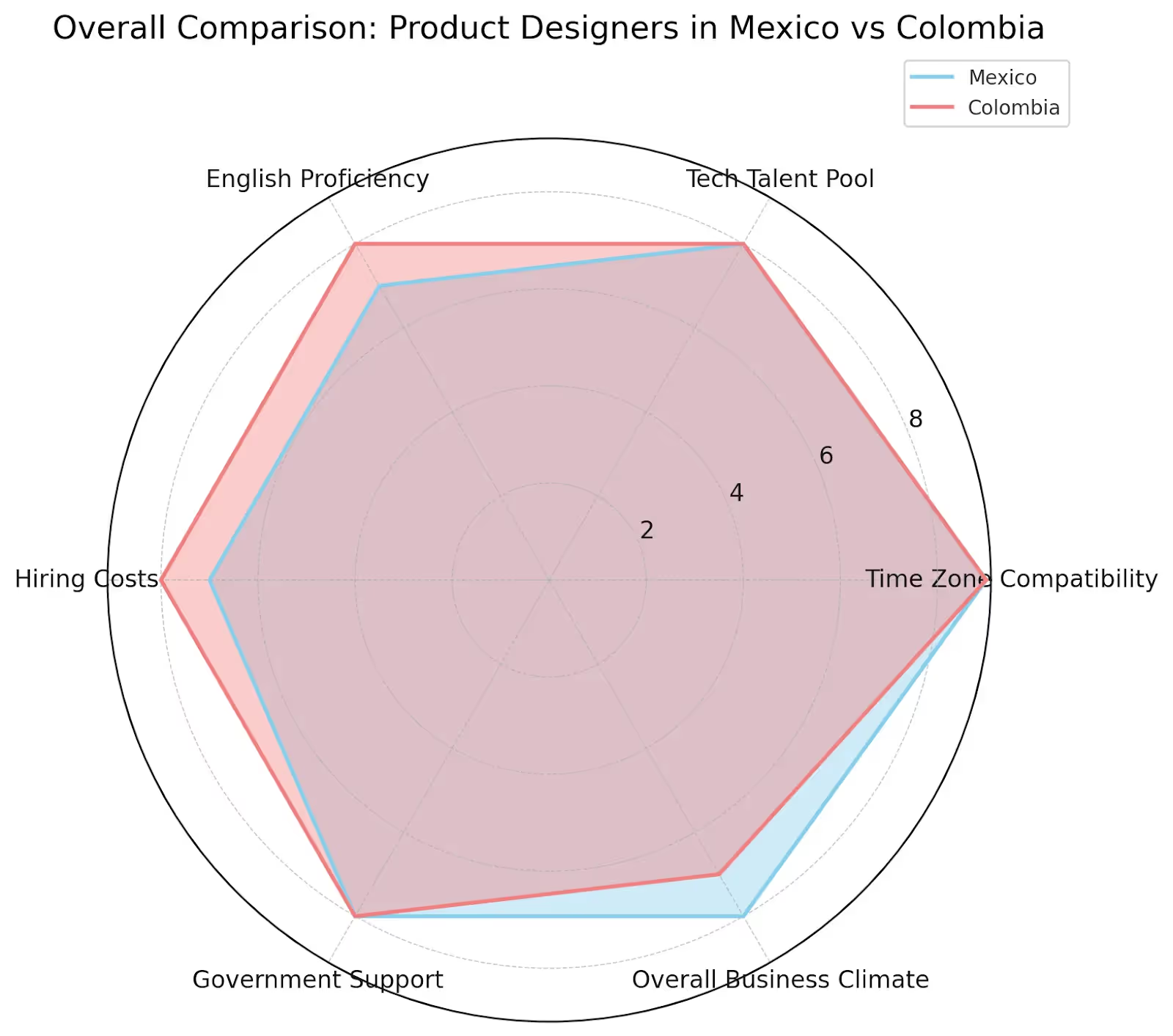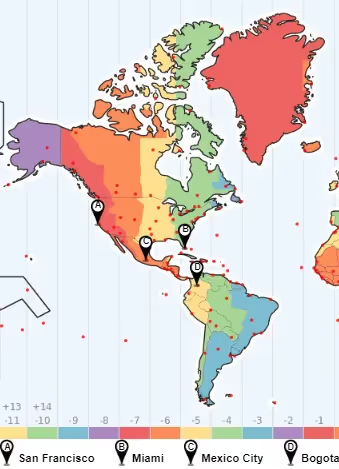Latin America has become a prime destination for hiring skilled product designers due to its favorable time zones and competitive rates. Mexico and Colombia are two prominent choices for nearshore technology outsourcing, each presenting unique benefits. This article compares Mexico and Colombia for hiring top product designers, focusing on key parameters such as time zone compatibility, tech talent pool, business climate, and English proficiency.
Hire Top Product Designers in Mexico vs Colombia
The radar chart above offers a comprehensive comparison between Mexico and Colombia across six critical parameters: Tech Talent Pool, Time Zone Compatibility, Government Support, Hiring Costs, English Proficiency, and Overall Business Climate. Each parameter is rated on a scale from 0 to 8, reflecting the relative strengths and weaknesses of each country in these areas.

Below, we present the six most relevant points to consider when deciding which country to choose for hiring top product designers.
Time Zone Compatibility for Product Designers in Mexico vs Colombia
Mexico:
Mexico’s geographical location offers full working day overlap with the US Midwest, making communication seamless. Major cities like Mexico City, Guadalajara, and Monterrey are within Central Time (CT), aligning well with many US business hours. Additionally, Mexico spans multiple time zones (Pacific, Central, and Eastern), providing flexibility for different regions in the US.
Colombia:
Colombia shares the same time zone as the US East Coast (ET), which is advantageous for companies based in cities like New York or Miami. This alignment facilitates real-time collaboration and efficient project management. The maximum time difference with the US is only 1 hour (when considering other time zones), ensuring that teams can work closely with minimal disruption.

Tech Talent Pool for Product Designers
Mexico:
Mexico has a robust ICT market, with 38 IT clusters throughout the country offering software development, call centers, high-tech manufacturing, and engineering services. The Mexican IT market saw a 9.4% growth in 2022, and it is expected to accelerate with higher private sector investment. Mexico is also a major mobile app market, with significant growth in app downloads and revenue.
Tech Hubs and Infrastructure in Mexico:
- Mexico City: The largest tech hub with numerous startups and established tech companies.
- Guadalajara: Known as the "Silicon Valley of Mexico," it hosts major tech firms and a vibrant startup ecosystem.
- Monterrey: A key industrial and tech center with strong university-industry collaboration.
Colombia:
Colombia's ICT market has been experiencing significant growth, with a 14.6% increase in 2022 and a projected 6.6% growth in 2023. The local software and services industry is a notable nearshoring center, with strengths in financial applications, digital animation, and mobile and web applications. The country benefits from strong investments in digital transformation and a growing tech ecosystem in major cities like Bogotá, Medellín, and Cali.
Tech Hubs and Infrastructure in Colombia:
- Bogotá: The capital city is the primary tech hub, with a growing number of tech companies and startups.
- Medellín: Recognized for its innovation, Medellín has a dynamic tech scene and numerous co-working spaces.
- Cali: An emerging tech hub with increasing investments in tech infrastructure and startups.
English Proficiency Level and Cultural Proximity for Product Designers
Mexico:
Mexico has a moderate level of English proficiency, with tech professionals in major cities often having a better command of the language. The cultural proximity to North America is strong, facilitating easier understanding of business requirements and expectations.
Colombia:
Colombia enjoys a higher level of English proficiency among its tech professionals. The country's close cultural alignment with the US further aids in smooth collaboration and communication.
Cost of Hiring Product Designers in Mexico vs Colombia
Mexico:
Hiring product designers in Mexico is cost-effective, with the average monthly cost being around $3,750. The lower cost of living and favorable exchange rate contribute to these attractive rates, making Mexico a cost-effective choice for nearshore outsourcing.
Colombia:
Colombia offers competitive rates for product designers, with the average monthly cost also being around $3,750. This cost parity, combined with a skilled talent pool, makes Colombia an appealing option for businesses looking to hire product design professionals.
Government Support and Policies for Product Designer Hiring
Mexico:
The Mexican government actively supports the tech industry through policies that promote ICT education and foreign investments. Initiatives such as tax incentives and the creation of tech parks have strengthened Mexico's position as a tech outsourcing destination. Additionally, simplified regulatory processes and substantial investments in digital infrastructure enhance the appeal of hiring skilled product designers in Mexico.
Colombia:
The Colombian government has implemented a range of initiatives designed to strengthen the tech sector. These include tax incentives for tech startups, substantial investments in digital infrastructure, and policies aimed at streamlining business regulations. The government is also fostering partnerships between local universities and international tech companies to drive innovation and skill development. These efforts are creating a more favorable business environment, enhancing Colombia’s appeal as a competitive tech outsourcing destination.
Future Outlook for Product Designers in Mexico and Colombia
Mexico:
Mexico's tech sector is poised for continued growth, driven by increasing investments in education and infrastructure aimed at enhancing product design capabilities. The government's support is expected to attract more foreign investments, leading to a highly skilled workforce adept in innovative design strategies.
Colombia:
Colombia's tech industry is rapidly growing, with substantial investments in education and infrastructure focusing on product design practices. The country's competitive rates and government initiatives are expected to result in a skilled workforce excelling in customer-focused design, user experience, and product innovation. This makes Colombia an increasingly attractive destination for businesses seeking top-tier product designers.
FAQs
Why should I hire a product designer in Mexico?
Mexico offers a large tech talent pool, favorable time zone compatibility with the US, and strong governmental support for the tech industry. The country’s established outsourcing industry and competitive rates make it a convenient choice for many businesses.
What are the benefits of hiring a product designer in Colombia?
Colombia provides competitive rates, a growing tech talent pool, and favorable government support for foreign investments. The country’s time zone compatibility with the US and high level of English proficiency facilitate smooth collaboration.
How does the cost of hiring product designers compare between Mexico and Colombia?
Both Mexico and Colombia offer competitive monthly rates for product designers, averaging around $3,750.
Which country has better English proficiency for tech professionals, Mexico or Colombia?
Colombia tends to have better English proficiency scores for tech professionals compared to Mexico, particularly in major IT hubs.
What are the main tech hubs in Mexico and Colombia?
In Mexico, the main tech hubs are Mexico City, Guadalajara, and Monterrey. In Colombia, the primary tech hubs are Bogotá, Medellín, and Cali.
What are the future prospects for the tech industry in Mexico and Colombia?
Both Mexico and Colombia have strong growth prospects for their tech industries. Mexico’s established infrastructure and government support position it well for continued growth. Colombia’s competitive rates and educational investments are driving rapid development in its tech sector.
Conclusion
Choosing between hiring product designers in Mexico or Colombia depends on various factors, including time zone compatibility, tech talent availability, business climate, and cost considerations. Mexico offers a larger talent pool and well-established infrastructure, while Colombia provides competitive rates and a rapidly growing tech industry. Both countries present compelling advantages for nearshore technology outsourcing, and the best choice will depend on your specific business needs and preferences.
To help you make the best decision, use the calculator below to estimate your costs and potential savings. For more details and personalized advice, please contact us.








